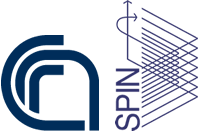
VIRGO
The scientific goal of the Virgo experiment (a suspended Michelson interferometer, with 3 km Fabry-Pérot cavities), is the direct detection of gravitational waves from astrophysical and/or cosmological sources. The first generation detector - Virgo - was able to demonstrate the technological feasibility of the experiment. It took data from May 2007 to September 2011, in four scientific runs (VSR1, VSR2,VSR3, VSR4) in coincidence with the LIGO interferometers, getting results of recognized scientific interest. Advanced Virgo the upgrade of Virgo to a second-generation detector, with the aim of increasing the number of observable galaxies (and thus the detection rate) by three orders of magnitude. Advanced Virgo is part of a network, alongside the two Advanced LIGO detectors in the US and GEO-HF in Germany, that contributed to the first direct detection of gravitational waves (GW150914, September 14, 2015) which marked an historical scientific achievement and opened a new window of observation on the universe. From August 1st, 2017, to August 25, 2017, Advanced Virgo joined the two LIGO detectors in the O2 scientific run. During O2, Advanced Virgo participated in the three-detector observation of gravitational waves from a binary black hole coalescence (GW170814, August 14, 2017) and in the first observation of gravitational waves from a binary neutron star inspiral (GW170917, August 17, 2017). During the two observational runs (O1 and O2) the Gravitational Wave network observed 11 events (10 from BBH and 1 from a BNS). After the completion of the post-O2 commissioning phase, Advanced Virgo started the new scientific run, O3, on April 1st, 2019 together with the LIGO detectors. The planned O3 duration is about 1 calendar year. The Virgo sensitivity has improved by almost a factor of 2, corresponding to an increase in the observable Universe (and in the expected event rate) of a factor of 8. The present sensitivity is about 50 Mpc for BNS and about 600 Mpc for BBH. The Virgo collaboration is also involved in R&D activities, considered and managed as sub-projects. These activities represent an intense effort to improve the performances of ground-based interferometric gravitational detectors in the short– and middle-term (AdV+ project) and to develop the technology needed for the realization of the third generation of gravitational wave detectors.
First Year Of Experiment Financing 1994 ; Experiment Duration (Years) 26
Experiment Location: EGO - European Gravitational Observatory, Cascina (PI), Italy
Local activities:
Coatings deposition and characterization, Thermal noise reduction, Optics design optimization, Data analysis.
Local hosting organizations:
Università di Salerno, Università del Sannio, CNR-SPIN Salerno
 |  |  |
Main equipment:
optical coating deposition facility (custom version of Optotech OAC-75F), room temperature AFM/AFS, cryogenic UHV AFM/STM, X-ray diffractometer, photolithography station, FE-SEM, EBL.
The local group:
(USS NCC 1707A): P. Addesso, F. Bobba, H. D. Cahyono, G. Carapella, F. Chiadini, R. De Simone, C. Di Giorgio, O. Durante, V. Fiumara, R. Fittipaldi, V. Granata, V. Matta, S. Marano, J. Neilson, I. M. Pinto, F. Postiglione, L. Troiano
Local P.I.:
Vincenzo Pierro, vpierro AT sa.infn.it